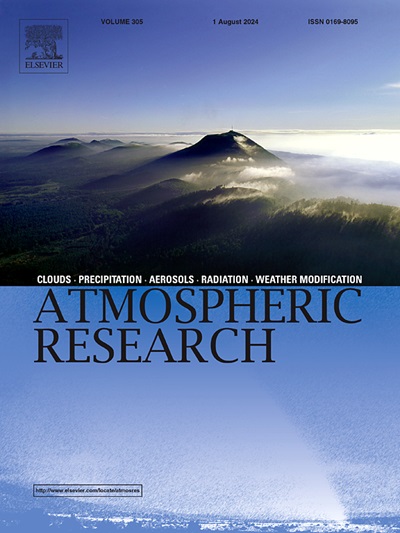Simulation of premonsoon thunderclouds over two climatic regimes: evaluation and dichotomous detection
IF 4.5
2区 地球科学
Q1 METEOROLOGY & ATMOSPHERIC SCIENCES
引用次数: 0
Abstract
This study investigates premonsoon (April) thundercloud properties over Northeastern (Kohima, 25.6°N, 94.1°E) and Eastern (Rampurhat, 24.2°N, 87.8°E) India. Thunderclouds were detected using Electric Field Mills (EFM-100) and Lightning Detectors (LD-350), while the WRF model was employed to simulate thundercloud properties. Simulations were performed across all 30 days in each region, regardless of actual thundercloud occurrence, to assess the model's accuracy in differentiating thundercloud and non-thundercloud days. The regional variability of cloud-to-ground (CG) flash density was well represented by the model, with higher flash densities in Rampurhat (mean: 39 × 10−4 km−2 h−1) compared to Kohima (mean: 31 × 10−4 km−2 h−1), consistent with observations. However, the model exhibited a slight overestimation in Kohima and an underestimation in Rampurhat, with spatiotemporal deviations from observations in both regions. Despite this, the simulations effectively captured regional differences in dynamical parameters (vertical velocity, wind shear) and microphysical properties (mixing ratios: qice, qgraupel, qcloud), with Rampurhat showing higher values overall. Six stability indices were evaluated to determine the most reliable indicator for distinguishing thundercloud/non-thundercloud days. In Kohima, the TT index (≥ 38 °C) was most effective, while in Rampurhat, CAPE (≥ 1680 J kg−1) proved more suitable, suggesting that distinct physical mechanisms drive thundercloud development in these regions. The dichotomous detection results for all 30 days in Kohima (Rampurhat) yielded 14 (21) successful detections, 5 (1) misses, 3 (1) false alarms, and 8 (7) correct rejections. We introduced the Correct Rejection Rate (CRR) to assess the model's performance in detecting non-thundercloud days, which showed better accuracy over Rampurhat than Kohima. The study underscores the heightened complexity of predicting thunderclouds over the hilly terrain of Northeastern India compared to the flatter terrain of Eastern India and offers valuable insights for improving strategies to mitigate lightning hazards.

求助全文
约1分钟内获得全文
求助全文
来源期刊

Atmospheric Research
地学-气象与大气科学
CiteScore
9.40
自引率
10.90%
发文量
460
审稿时长
47 days
期刊介绍:
The journal publishes scientific papers (research papers, review articles, letters and notes) dealing with the part of the atmosphere where meteorological events occur. Attention is given to all processes extending from the earth surface to the tropopause, but special emphasis continues to be devoted to the physics of clouds, mesoscale meteorology and air pollution, i.e. atmospheric aerosols; microphysical processes; cloud dynamics and thermodynamics; numerical simulation, climatology, climate change and weather modification.
 求助内容:
求助内容: 应助结果提醒方式:
应助结果提醒方式:


